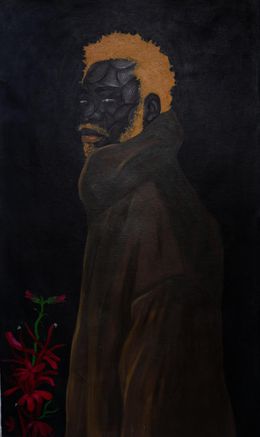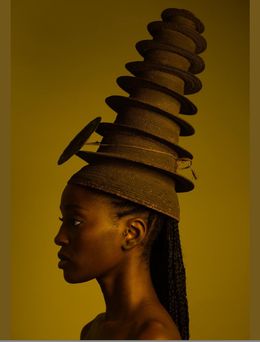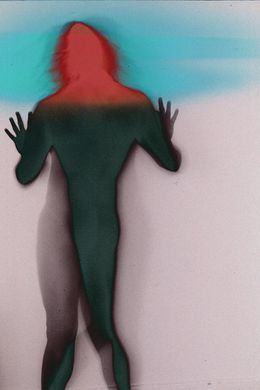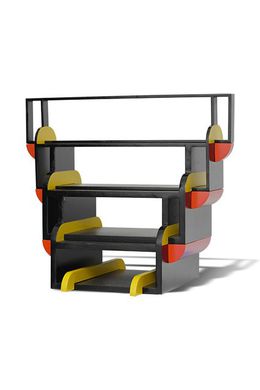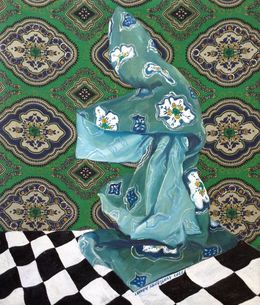
Meet Julia Daka: Mayotte-born architect, designer and curator, cultivating the next generation of artists

Image from Sadaka's exhibition "Memories of Forms" Émile Kirsch, Brut Collectif at 3557.org © Renaud Labelle
Join Artsper as we sit down with the formidable Julia Daka, the creative force behind Sadaka. A qualified architect, designer and model, Julia's journey to art curation has been grounded in a desire to bring the experiences and creative efforts of young people to light. Galvanizing the artistic efforts of young people across Mayotte and East Africa, Julia truly is cultivating the next generation of creative minds. Discover Julia's career journey, unique artistic philosophy and current art favorites today!
1. Welcome Julia! You started your career as an architect, then model, and now a curator. Could you tell us about your career journey?
From what I can remember, everything started from a pretty early age. I used to be really enthusiastic about my art classes at school. It was my art teacher who first introduced me to architecture and gave me a book on the Bauhaus style. Architecture became my first love, and I immediately knew that I wanted to be part of that world. 13 years later, the hustle and the hard work paid off. It wasn't easy but the dream became a reality. My work as a model is actually one of the most important parts of this journey, as it allowed me to finance my Masters degree in Architecture and Product Design in Paris, which I graduated from in 2019. Afterwards, I started to work for some amazing studios, such as BIG GAME in Switzerland and Constance Guisset in Paris. I eventually started my own studio and now, here we are.
2. You founded Sadaka in 2020. Can you tell us a little bit about the organization's ethos, and what led you to start your own cultural artistic residency association?
Sadaka ( @sadaka.fr on Instagram) can be thought of as a residency program with a focus on contemporary artistic projects, exploring themes related to photography, architecture, design, and fine arts, for isolated and out of school children in Mayotte (often referred to as the biggest open-sky orphanage of France). I want it to be a new kind of residency, intended for young creatives with committed minds, in a more human, supportive, and creative way. Artists coming from diverse backgrounds are given the opportunity to share their vision and experience an atypical creative journey, bonding with the kids involved in the program. I curate projects involving the most motivated and passionate artists, specifically chosen to inspire the kids in our program. I want to encourage them to express their own identities, through their favorite artistic styles. An amazingly diverse group of people, coming together with different strengths and backgrounds but sharing the same core values.
My choice of artists is based on a shared vision of art as an educational, benevolent, social and humanist possibility, showing that beyond aesthetics, the artist still has a role to play and the possibility to act responsibly. The association's mission is to bring together creators and talents from all over the world to create residency programmes and shine a light on the young people in Mayotte.


Left to right: Images from Sadaka's exhibition "Memories of Forms" Émile Kirsch, Brut Collectif and Marvin Bonheur at 3557.org © Renaud Labelle
3. Has your experience as a model shaped your artistic preferences? Are there any design styles which particularly resonate with you?
Modeling is what led me to the fashion world and my encounter with fashion designers and their own artistic universes. Yohji Yamamoto especially inspired me. I read his book “MY DEAR BOMB" and really loved how he processes his creative journey, turning emotions and philosophical guidelines into personal design principles. I always feel like many designers don't really want to linger over the struggles preceding success, but Yohji Yamamoto is really honest when it comes to the difficulties of the journey.
4. You live and work in Paris, and you are a Mayotte native. Do you feel that your cultural heritage plays a role in your creativity?
Being a Mayotte native has definitely shaped most of my core values and thinking. I feel like Mayotte's culture revolves a lot around “sharing". The sentiment of solidarity is something I always experienced growing up, and Sadaka is the result of that.
5. What has been your favorite project to date?
I would say my very first event and exhibition "Mémoires des formes" on January 5th 2023. I presented @sadaka.fr at @3537.org. I curated the exhibition, using documents which displayed the experiences and challenges of young people on the island, which are too often left out of the conversation. The artist, photographer and designer (respectively Émile Kirsch, Marvin Bonheur and Kevin Dizami) guide the viewer through more than one hundred works, the collective expression of the youth of Mayotte and question the forms of existence, and the disparate norms established by France.
For 3 weeks, @monsieurbonheur, @emile_kirsch and @kedizami followed me in Mayotte and shared their vision and passion with the youth there. The residency "Memory of Forms" aims to highlight art in all its forms. As stated by Émile Kirsch, "An exploration of a common genius, a collective gesture. Transforming representation into experimentation, identity into multitude."


Left to right: Julia standing in front of her "Mémoire des Formes" collection, image of the collection, Émile Kirsch, Brut Collectif © Renaud Labelle
6. Lastly, is there any advice that you would offer to a budding art curator?
Two quotations come to mind. "Starve your doubts, feed your dreams" and "No matter how hard it is, you must always create the opportunities."
I think that in life you have to move based on opportunities. If you have an opportunity to make a living doing exactly what you dream of, you have to pursue that when you can. That's what I did, I saw the opportunity and I chose to take it.
Their favorite artworks
